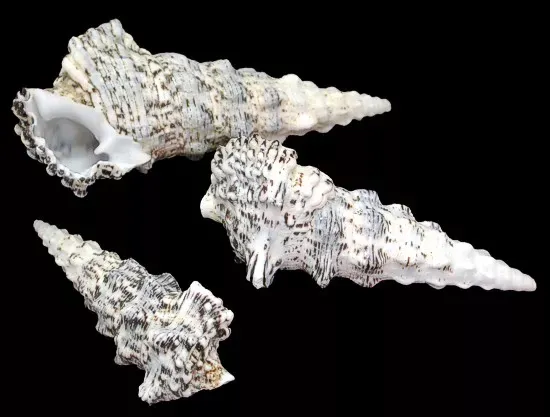One quarter pound of Knobby Cerithium shells, measuring between 2 and 3.5 inches. *******
One quarter pound of hand-selected Cerithium caeruleum (Knobby Cerithium) shells, measuring between 2 and 3.5 inches
Orders usually process within 2 to 5 business days.
Email us at ja1@mindspring.com Make Your Selections and Shipping Preference. We Will Email You the amount of the Shipping Cost. When you receive the shipping cost go back into Shells of Aquarius and click into Purchase Shipping Label. There you will find UPS or USPS. Click into the option you decided on and make your payment. Your order will ship when shipping payment is received.
Cerithium caeruleum, the Cerith sand snail, is a species of sea snail, a marine gastropod mollusk in the family Cerithiidae. Cerithium caeruleum, also be called Cerithium caeruleum G.B. Sowerby II, 1855 generally can be found in large populations on intertidal rocky shores and are covered by a thin layer of sediments. They have large and solid shells, and their radula ribbon is robust long and about one-fifth of the shell length. This species lives in the planktonic stage lasts from 90 to 120 days and has a seven-year life history. This common intertidal species is confined to east Africa, Madagascar, and the Arabian Peninsula and is unlikely to be confused with any other Cerithium species. It is distinguished by its squat, knobby shape; and as indicated by its name, caeruleum, a grayish blue color with spiral rows of black tubercles.
radula a structure of tiny teeth used for scraping food particles off a surface and drawing them into the mouth.
planktonic the small or microscopic organisms that drift or swim weakly in a body of water.This species is widespread in the tropical Indo-Pacific (Red Sea, Kenya, Madagascar, Mozambique, Tanzania and Western India). The shell of Cerithium caeruleum is large, solid, stocky, knobby, reaching 1 2/3 length to 3/4 inch width, and comprising 8-12 angulate, nodulose whorls. Early teleoconch whorls sculptured with 2 or 3 spiral cords, numerous fine spiral lirae, and weak axial ribs. Adult teleoconch whorls angulate, sculptured with numerous spiral lirae separated by incised spiral lines, fine, colabral axial lines, and with two dominant spiral cords— small, beaded, belt-like, subsutural cord, and very large, nodulose, median cord. A median spiral cord of penultimate whorl has 8-12 large nodes and a wide sutural ramp. Nodes are sometimes spiny and axially drawn out. The suture is slightly impressed. Body whorl is large, wide, elongate, with weak siphonal constriction. Body whorl microsculpture same as on adult whorls, but with 4 or 5 major nodulose, beaded, or nearly smooth, spiral cords. The aperture is ovate, a little more than one-third the shell length. Columella concave with moderate thick callus. Anterior siphonal canal is short and strongly reflected left of shell axis. Anal canal is deep and folded into weak inner denticles. Shell color is grayish-blue flecked with white; nodes black, early whorls white.
teleoconch The portion of the shell formed immediately after the larval stage of the life cycle of the organism
whorl(a circular pattern of lines, with the smallest circle in the middle, surrounded by other circles,
nodulosea small rounded lump of matter distinct from its surroundings
Columellaa small column
siphonal to draw liquid by means of a siphon
denticles any small tooth-like or bristle-like structure
The egg capsules of C. caeruleum each have a diameter of about 6 inches, and there is an incubation period of 4–5 days prior to hatching. Reproductive studies and growth statistics calculated by Ayal and Safriel provide evidence that this species lives from 90 to 120 days in the plankton and has a seven-year life expectancy
Foraging fish are the major predators of juvenile Cerithium caeruleum. Taylor and Reid found the murex snails to be the major predator of adult populations. Adult prey were attacked through the aperture, while smaller individuals were usually drilled through the spire.
These species dwell in intertidal rocky shelfs with a thin covering of sediment. They live in the upper intertidal zone on beach stones. The Cerithium caeruleum survive in a wide range of environmental gradients.
These species live along the continental margins of the western Indian Ocean where it is found as far south as Natal and Madagascar. They also are found on Aldabra Atoll and in the Red Sea and Persian Gulf, extending eastward to the coasts of Pakistan and western India. They feed on algae and detritus (waste or debris of any kind).
